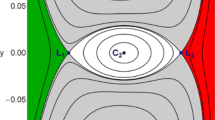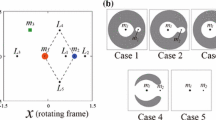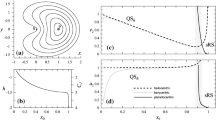Abstract
We investigated the stable area for fictive Trojan asteroids around Neptune’s Lagrangean equilibrium points with respect to their semimajor axis and inclination. To get a first impression of the stability region we derived a symplectic mapping for the circular and the elliptic planar restricted three body problem. The dynamical model for the numerical integrations was the outer Solar system with the Sun and the planets Jupiter, Saturn, Uranus and Neptune. To understand the dynamics of the region around L 4 and L 5 for the Neptune Trojans we also used eight different dynamical models (from the elliptic problem to the full outer Solar system model with all giant planets) and compared the results with respect to the largeness and shape of the stable region. Their dependence on the initial inclinations (0° < i < 70°) of the Trojans’ orbits could be established for all the eight models and showed the primary influence of Uranus. In addition we could show that an asymmetry of the regions around L 4 and L 5 is just an artifact of the different initial conditions.
Similar content being viewed by others
References
Brown E.W., Shook C.A.: Planetary Theory. Dover Publications, New York (1964)
Chambers J.E.: A hybrid symplectic integrator that permits close encounters between massive bodies. MNRAS 304, 793–799 (1999)
Dvorak R., Schwarz R.: On the stability regions of the Trojan asteroids. CeMDA 92, 19–28 (2005)
Dvorak R., Schwarz R., Süli Ä., Kotoulas T.: On the stability of the Neptune Trojans. MNRAS 382, 1324–1330 (2007)
Efthymiopoulos C., Sándor Z.: Optimized Nekhoroshev stability estimates for the Trojan asteroids with a symplectic mapping model of co-orbital motion. MNRAS 364, 253–271 (2005)
Freistetter F.: The size of the stability regions of Jupiter Trojans. A&A 453, 353–361 (2006)
Hadjidemetriou, J.D.: In mapping models for Hamiltonian systems with application to resonant asteroid motion. In: Roy, A.E. (ed.) Predectibility, Stability and Chaos in N-Body Dynamical System, p. 157. Plenum Press, New York (1991)
Hanslmeier A., Dvorak R.: Numerical integration with Lie series. A&A 132, 203–207 (1984)
Holman M.J., Wisdom J.: Dynamical stability in the outer Solar system and the delivery of short period comets. AJ 105, 1987–1999 (1993)
Lhotka Ch., Efthymiopoulos C., Dvorak R.: Nekhoroshev stability at L4 or L5 in the elliptic-restricted three-body problem—application to Trojan asteroids. MNRAS 384, 1165–1177 (2008)
Li J., Zhou L.-Y., Sun Y.-S.: The origin of the high-inclination Neptune Trojan 2005 TN53. A&A 464, 775–778 (2007)
Lichtenegger H.: The dynamics of bodies with variable masses. CeMDA 34, 357–368 (1984)
Marzari F., Tricarici P., Scholl H.: The MATROS project: stability of Uranus and Neptune Trojans. The case of 2001 QR322. A&A 410, 725–734 (2003)
Nesvorný D., Dones L.: How long-lived are the hypothetical Trojan populations of Saturn, Uranus, and Neptune?. Icarus 160, 271–288 (2002)
Queck M., Krivov A.V., Sremčević M., Thébault.: Collisional velocities and rates in resonant planetesimal belts. CeMDA 99, 169–196 (2007)
Robutel P., Gabern F.: The resonant structure of Jupiter’s Trojan asteroids—I. Long-term stability and diffusion. MNRAS 372, 1463–1482 (2006)
Robutel P., Gabern F., Jorba A.: The observed Trojans and the global dynamics around the Lagrangian points of the Sun Jupiter System. CeMDA 92, 53–69 (2005)
Sándor Z., Érdi B.: Symplectic mapping for Trojan-type motion in the elliptic restricted three-body problem. CeMDA 86, 301–309 (2003)
Schwarz R., Gyergyovits M., Dvorak R.: On the stability of high inclined L4 and L5 Trojans. CeMDA 90, 139–148 (2004)
Schwarz R., Dvorak R., Süli Á., Érdi B.: Stability of fictitious Trojan planets in extrasolar systems. AN 328, 785–788 (2007a)
Schwarz R., Dvorak R., Süli Á., Érdi B.: Survey of the stability region of hypothetical habitable Trojan planets. A&A 474, 1023–1029 (2007b)
Author information
Authors and Affiliations
Corresponding author
Rights and permissions
About this article
Cite this article
Dvorak, R., Lhotka, C. & Schwarz, R. The dynamics of inclined Neptune Trojans. Celest Mech Dyn Astr 102, 97–110 (2008). https://doi.org/10.1007/s10569-008-9136-7
Received:
Revised:
Accepted:
Published:
Issue Date:
DOI: https://doi.org/10.1007/s10569-008-9136-7




